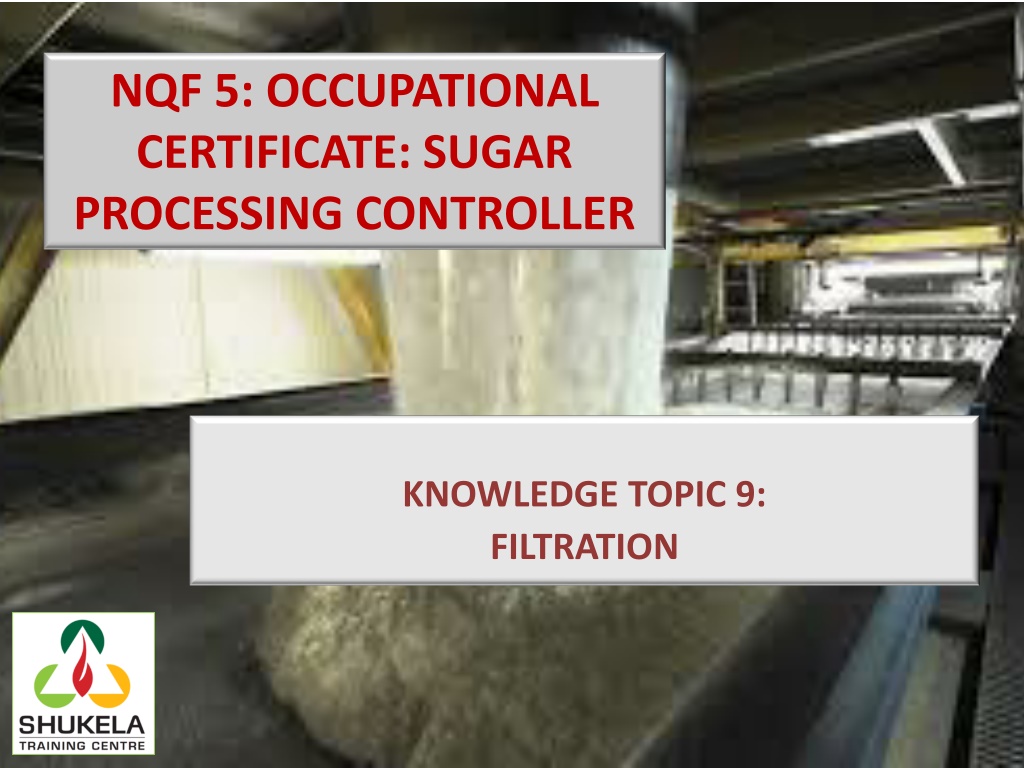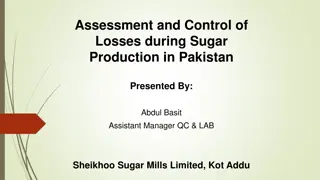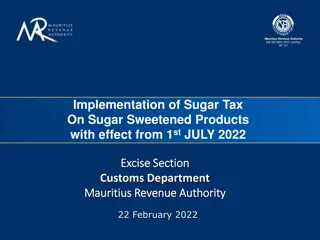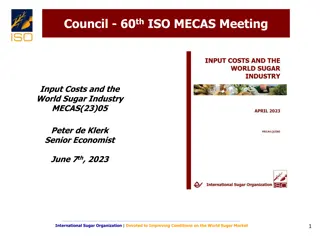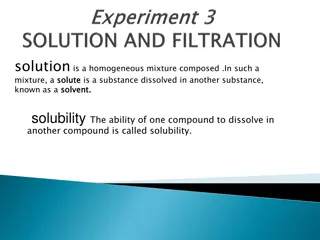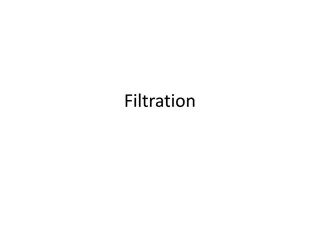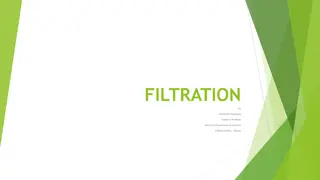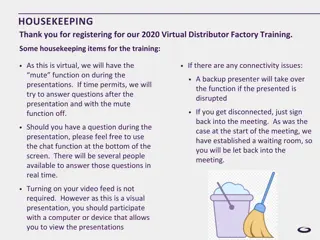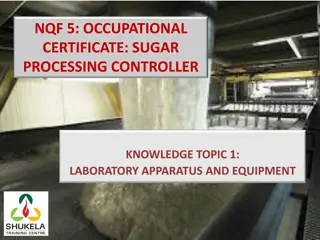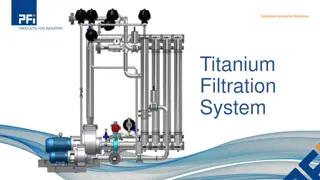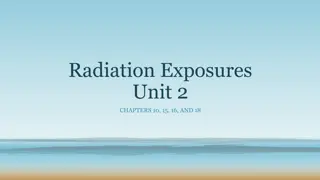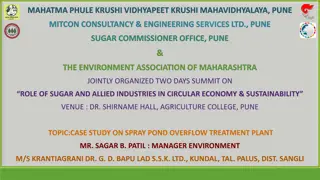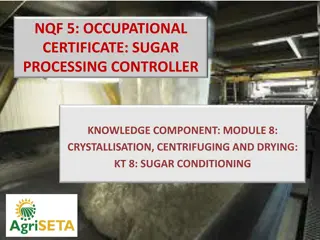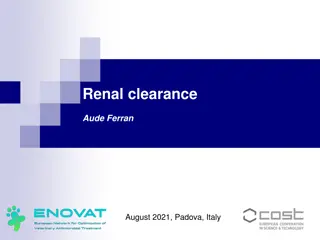Understanding Filtration in Sugar Processing
Filtration in sugar processing involves separating solid materials from liquids. The process is crucial for quality control and analysis. Different filter papers are used based on the substances to be removed. Proper folding of filter paper is essential for effective filtration. Understanding the principles of filtration is vital for a successful sugar processing operation.
Download Presentation

Please find below an Image/Link to download the presentation.
The content on the website is provided AS IS for your information and personal use only. It may not be sold, licensed, or shared on other websites without obtaining consent from the author. Download presentation by click this link. If you encounter any issues during the download, it is possible that the publisher has removed the file from their server.
E N D
Presentation Transcript
NQF 5: OCCUPATIONAL CERTIFICATE: SUGAR PROCESSING CONTROLLER KNOWLEDGE TOPIC 9: FILTRATION
INTRODUCTION Filtration is a process whereby the solid material is separated from the liquid part of a mixture. The liquid that passes through the filter paper is called the filtrate. The solids that remain on the filter paper is called the residue. Filtration can be carried out in a number of ways. In a normal sugar mill laboratory it is done by gravity, by vacuum or by using pressure. Insoluble particles can be removed by filtration
INTRODUCTION (2) Effective filtration is dependent on the sizes of the holes / pores in the filter paper (filtering medium). Obviously the holes in the filter paper must be smaller than the particles that we wish to remove. Consider a mixture of insoluble substances of different particle sizes, for example a mixture of marbles, sand and Talcum powder. By filtering with filters of different porosity (pore size), it is possible to separate the different substances. In this example we would require different sieves. It is important to note that filtration only removes those substances that do not dissolve i.e. insoluble substances. For example, if some sand and sugar are added to a beaker containing water, the sugar will dissolve and the sand will settle to the bottom. Filtering this mixture removes only the sand.
INTRODUCTION (3) The analytical procedure during filtration differs depending on whether we require the filtrate or residue for analysis. If the filtrate is required, the residue on the filter paper is NOT washed with water or other solvents, since this would dilute the filtrate. Example: pol, brix and colour. However, if the residue is required, the residue remaining on the filter paper must be washed. Example: suspended solid analysis and starch analyses.
FILTER PAPER Six different grades or filter media are used in the laboratory. They are: Whatman No. 1 filter paper insoluble matter in juice Whatman No. 5 filter paper starch Whatman No. 6 filter paper brix and turbidity Whatman No. 91 filter paper pol and starch Whatman G.F.A (glass fibre) insoluble matter in effluent. 0,45 m cellulose membrane - colour You will notice that each of the above filter papers look and feel different because the sizes of their holes / pores are different. Papers must never be used for the wrong application as errors will result due to cloudy filtrates, slow or too rapid filtration.
FOLDING FILTER PAPER When a filter paper is folded, the creases must not be sharp. If they are sharp the paper is weakened and poor filtration can result. First fold the paper in half, crease lightly and then fold in half again. Open the paper to the half folded position and fold the ends to the middle. Again open the paper to the half folded position. Proceed to concertina fold the filter paper as follows: Open the filter paper and press into a filter funnel. The uneven (crepe) surface of Whatman No. 91 paper with its ridges and grooves promotes filtration by facilitating drainage.
FILTER AID (1) Primarily used to: Improve the filtration rate Increase the clarity of the filtrate Inert i.e. it does not change the composition of the sample but acts like an extra piece of filter paper provided it is used correctly. Usually a mixture to be filtered contains substances of varying particle sizes. If one of the constituents consists of particles that are about the size of pores in the filter paper, they will cause these pores to block / blind thus preventing the rest of the solution from passing through the filter.
FILTER AID (2) To prevent blockage, a filter aid, like Celite, is used. Forms a mat called a depth filter which retains the smaller particles but also maintains drainage due to the spaces between the particles of the filter aid. Two types of filter aid are used in the laboratory: Acid washed Kieselguhr Celite 577 Celite 577 may be used only for brix and suspended matter. When doing gravity filtration the filter aid must be well mixed with the sample and poured into the folded filter paper immediately (This ensures that the entire surface of the filter paper is coated with the filter aid and the filtration will be improved). When doing a vacuum filtration the filter pad is first prepared with the filter aid and then the sample can be poured slowly onto the mat of filter aid.
CLARIFICATION AGENT Basic lead sub-acetate Used to clarify solutions of pol determinations. The dry lead acts chemically on the sample forming a floc which, when removed by the filter, leaves a clear filtrate. The quantity of lead used is important. Too little or too much lead will lead to poor filtration and/or incorrect readings. Definition of floc: .. a loosely clumped mass of fine particles ..
GRAVITY FILTRATION (BRIX & POL)(1) Done in the following manner: Pour approximately 100cm3 of juice (for brix) or 200cm3 of juice (for pol), into a clean, dry glass bottle, fitted with a stopper. Add the required amount of lead (for pol analysis) or 1g of filter aid (for brix analysis). Fit the stopper and shake well. Place a filter funnel containing the required filter paper into a beaker. If it is brix filtration the juice must be poured into the folded filter paper immediately before the filter aid can settle out.
GRAVITY FILTRATION (BRIX & POL)(2) It is important to push the folded filter paper down into the filter funnel and to hold it down while the solution is poured with the other hand (This will allow the watch glass to be supported by the rim of the filter funnel, thus forming a better seal). During pol filtration, allow the solution to stand to allow the floc to form. The time it takes will depend on the product being analysed. Once the floc has formed, pour the sample into the folded filter paper.
GRAVITY FILTRATION (BRIX & POL)(3) The funnel must now be covered with a watch glass to minimise evaporation. The first 10 25cm3 of filtrate (first runnings) must be discarded and the funnel transferred to a clean and dry breaker. This is very important because the first runnings are more concentrated than the rest of the solution due to water being withdrawn during the wetting of the filter paper. The first runnings may also be cloudy due to some small particles of filter aid or precipitate / residue being initially washed through the filter paper.
VACUUM FILTRATION (1) Done in two stages: Precoating Filtration The precoating is done to form a mat of filter aid on the filter paper to improve the filtration. Fit a Buchner funnel and rubber cone into a filter flask. Connect the flask to a source of vacuum (a pump or water jet).
VACUUM FILTRATION (2) Place the filter in the funnel the right way around and, under low vacuum, wet the paper with water. It is important to ensure that the paper fits neatly and is flat. The precoating can now take place. Depending on the analysis 2 5g of Kieselguhr is massed into a beaker. Add water, or alcohol if starch is being determined, and make a slurry. Pour the slurry down a glass rod onto the paper.
VACUUM FILTRATION (3) Rinse the beaker and rod with a wash bottle to remove all the filter aid. Low vacuum is used to form the filter pad. The filtration can now be carried out. Assume that the residue is required. The juice is poured slowly down a glass rod onto the precoated filter paper. When analysing for suspended solids the juice must be poured at a rate slower than the drainage rate of the paper (This is important since a layer of liquid must NOT form over the mat).
VACUUM FILTRATION (4) While filtering, stir the beaker contents. Note: This applies to suspended solids determinations but not to starch whose washing by decantation is preferable. Since the residue is required wash the glass rod off into the beaker, wash the side of the beaker, pour the solution into the Buchner and rinse the beaker several times into the Buchner using the wash bottle. Keep the spout of the beaker over the funnel until this has been done then wash the inside and outside of the spout. Touch the spout to the inside surface of the funnel to remove the last drop (This practice will ensure that none of the solution runs down the outside of the beaker).
VACUUM FILTRATION (5) Increase the vacuum and wash the filter with distilled water or alcohol (depending on the analysis). Allow the filter to drain between washings. Allow the filter to drain for 5 minutes under vacuum. Release the vacuum. The filter paper and contents can now be removed. When performing suspended solids analysis the filter paper supplied has a greater diameter than the Buchner funnel used.
VACUUM FILTRATION (6) Use an object (e.g. a beaker) that just fits into the Buchner funnel and press the paper in, then flatten the folds so that they form pleats around the sides. In cases where the filtrate is required, the vacuum flask is changed for a dry clean one after the first runnings have been collected. At the end of the filtration, do not rinse the beaker as this will dilute the filtrate.
PRESSURE FILTRATION (NUTSCH) The basic principle involves placing a sample of massecuite over a sieve and applying air pressure to force the mother liquor through the sieve while the sugar crystals remain behind. The mother liquor is called a NUTSCH sample and is analysed for pol and brix. Depending on where the sample has been taken, the purity of the mother liquor can be used to assess the work done in the crystallisers, reheaters and the centrifugals. Massecuite definition: a dense mass of sugar crystals mixed with mother liquor obtained by evaporation .
